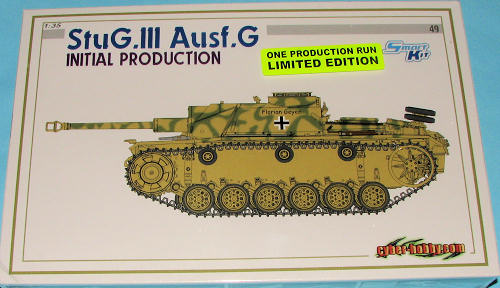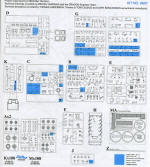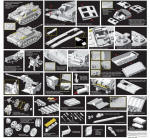
| KIT #: | 6607 |
| PRICE: | $62.00 MSRP |
| DECALS: | Three options |
| REVIEWER: | Scott Van Aken |
| NOTES: | Smart Kit |

| HISTORY |
Overall, Sturmgeschütz series assault guns proved very successful and served on all fronts as assault guns and tank destroyers. Although Tigers and Panthers have earned a greater notoriety, assault guns collectively destroyed more tanks. Because of their low silhouette, StuG IIIs were easy to camouflage and a difficult target. Sturmgeschütz crews were considered to be the elite of the artillery units. Sturmgeschütz units held a very impressive record of tank kills – some 20,000 enemy tanks by the spring of 1944. As of April 10, 1945, there were 1,053 StuG IIIs and 277 StuH 42s in service. Approximately 9,500 StuG IIIs of various types were produced until March 1945 by Alkett and a small number by MIAG.
In terms of the resources expended in their construction, the StuG assault guns were extremely cost-effective compared to the heavier German tanks, though in the anti-tank role, it was best used defensively, as the lack of a turret would be a severe disadvantage out in the open. As the German military situation deteriorated later in the war, more and more StuG guns were constructed in comparison to tanks, in an effort to replace losses and bolster defences against the encroaching Allied forces.
In 1944, the Finnish Army received 59 StuG III Ausf. Gs from Germany (30 Stu 40 Ausf.G and 29 StuG III Ausf. G) and used them against the Soviet Union. These destroyed at least 87 enemy tanks for a loss of only 8 StuGs (some of these were destroyed by their crews to avoid capture). After the war, they were the main combat vehicles of the Finnish Army until the early 1960s. These StuGs gained the nickname "Sturmi" which can be found in some plastic kit models.
100 StuG III Ausf. G were delivered to Romania in the autumn of 1943. They were officially known as TAs (or TAs T3 to avoid confusion with TAs T4) in the army inventory. By February 1945, 13 units were still in use with the 2nd Armoured Regiment. None of this initial batch survived the end of the war. 31 TAs were on the army inventory in November 1947. Most of them were probably StuG III G and a small number of Panzer IV/70 (V), known as TAs T4. These TAs were supplied by the Red Army or were damaged units repaired by the Romanian Army. All German equipment was scrapped in 1954 because the Army's decision to use Soviet armour.
StuG IIIs were also exported to other nations like Bulgaria, Hungary, Italy and Spain.
Many German Sturmgeschütz IIIs were captured by Yugoslav Partisans. After the war, they were used by the Yugoslav Peoples Army until the 1950s.
After the Second World War, the Soviet Union donated some of their captured German vehicles to Syria, which continued to use them at least until the Six Days War (1967).
Today, examples have been kept in running condition, including one seen in the movie Mr. Bean's Holiday.
StuG III Ausf. G (Sd.Kfz. 142/1; Dec 1942– Apr 1945, 7,720 produced, 173 converted from Pz.Kpfw. III chassis): The final, and by far the most common, of the StuG series. The Ausf. G used the hull of the Pz.Kpfw. III Ausf. M. Upper superstructure was widened: welded boxes on either sides were abandoned. This new superstructure design increased its height to 2160mm. Backside wall of the fighting compartment got straightened, and ventilation fan on top of the superstructure was relocated to the back of fighting compartment. From March 1943, driver's periscope was abandoned. From May 1943, side hull skirts (schurzen) were fitted to G models for added armor protection particularly against anti-tank rifles. Side skirts were retro-fitted to some Ausf. F/8 models. Side skirts were also to be fitted to all front line StuGs and other tanks by June 1943 in preparation for the battle of Kursk. Mountings for side skirts proved inadequate, many were lost in the field. From March 44, improved mounting was introduced, as a result side skirts are more often seen with late model Ausf G. From May 1943, 80mm thick plates were used for frontal armor instead of two plates of 50mm+30mm. However, backlog of completed 50mm armors exited. For those, 30mm additional armors still had to be welded or bolted on, until Oct 1943.
| THE KIT |

 This is another of Cyber-hobby's one time release kits and is of the initial production StuG III G that started leaving the production lines in December of 1942. Typical of Smart Kits, everything you need to produce a superb replica is in the box with no real need for aftermarket. The individual link Magic Tracks will reproduce the sag normally seen on German tanks. The photo etch fret is appropriate and not overwhelming, something that most modelers will appreciate. There is the usual long list of features and they are below.
This is another of Cyber-hobby's one time release kits and is of the initial production StuG III G that started leaving the production lines in December of 1942. Typical of Smart Kits, everything you need to produce a superb replica is in the box with no real need for aftermarket. The individual link Magic Tracks will reproduce the sag normally seen on German tanks. The photo etch fret is appropriate and not overwhelming, something that most modelers will appreciate. There is the usual long list of features and they are below.

Markings are provided for three vehicles in various camouflage schemes. The white winter wash StuG is from StuG Abt 226 from Leningrad in 1943. The center one is also the box art vehicle from StuG Abt 2,PzGren Div 'Das Reich' at Kursk in 1943. Finally the one with no additional camo is from an unidentified Eastern Front unit in 1943. The small decal sheet is well printed.
| CONCLUSIONS |
If you like StuGs as much as do I, then you really need to have this one on your short list of kits to buy. But you need to make your move soon as these one production run kits don't seem to stay on the shelves very long.
| REFERENCES |
http://en.wikipedia.org/wiki/StuG_III March 2010
Thanks to www.dragonmodelsusa.com for the preview kit. You can get yours today at your local shop or on-line retailer. If you would like your product reviewed fairly and fairly quickly, please contact the editor or see other details in the Note to Contributors.